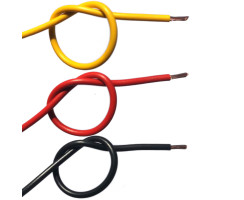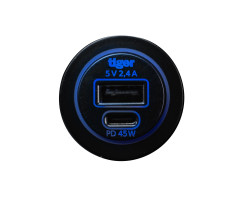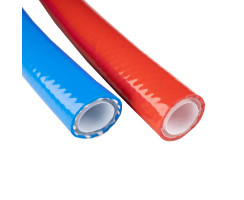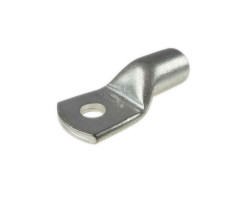USB-C / USB-A charging socket with buck-boost converter
What is the difference to a normal USB charging socket?
Travel vehicles are in most cases equipped with an on-board electrical on-board voltage of 12V. The problem: Powerful devices, especially those with fast charging protocols, often require higher electrical output, both in terms of voltage and current, than a standard 12V electrical system can normally deliver. As a rule, inverters and power supplies or bulky adapters are used here, which may make the electrical installation unnecessarily complex and expensive.
The convertiger 100 solves this problem without having to convert into alternating current. Thanks to the Buck-Boost Converter, it increases the 12V input voltage to up to 20V / 5A (100W max.) at the USB-C output when required via device and cable*. This means that fast charging protocols such as Quick Charge or Power Delivery can finally be used in a 12-V system without any problems.
Avoiding an inverter also saves valuable power reserves because it not only consumes energy in standby mode, but also a certain percentage of the power used to transform it into the required alternating current.
Charging at 100W depends on factors such as the requirement of the device being charged (considering its current charging state), the cable used, input voltage, and ambient temperature. Install the charger in a well-ventilated area, as excessive temperatures will automatically throttle down the power output.
If the power consumption of a device consistently remains in the 100W range, the input voltage should be 24V. For a 12V system, it is preferable to operate via an inverter for this application.
Auto light off - for undisturbed sleep
The current charging voltage is shown via an LED display for 20 seconds after plugging in the charging cable. After this time the display goes out automatically. After another 10 seconds, the backlight will also be switched off automatically. The charging socket does not produce any light that disturbs you when you fall asleep or consumes unnecessary (albeit minimal) power.
Compatible with the Berker installation system
Our Buck-Boost charging socket in this version fits into the Berker INTEGRO installation system, which is often used in the vehicles of many large motorhome brands and also by self-builders. The convertiger 100 therefore fits optically and harmoniously into the existing equipment even when retrofitting. Simply select from the dropdown menu. accordingly, whether you would like to receive a mounting frame from this system directly with your convertiger100 and what color it should be.
In the Switch program configurator you can also put together additional sockets and switches with 1-way, 2-way or 3-way mounting frames in different designs in just a few steps in addition to the convertiger100.
Alternatively is the convertiger100 Buck-Boost charging socket for the Installation in the Inprojal 20,000 system available.
Specifications
Input voltage: DC 9-30V
Output power: max. 100W
Cable thicknesses
The following guidelines apply to the cable thicknesses to be used for installation:
* The cable lengths specified correspond to the total length of the plus and minus cable (fuse box - charger - fuse box).
Cable length* 12V 24V
4m 2.5 sqmm 1.5 sqmm
7m 4 sqmm 2.5 sqmm
10m 6 sqmm 4 sqmm
Low standby consumption:
13V: 10.19mA = 0.132W
26V: 6.93mA = 0.180W
Important to know: charging standards
There are various fast charging protocols in the world, which unfortunately are implemented very heterogeneously on the market. Apple was actually always the pioneer with a protocol that implemented exactly this 2.4A, which was adopted by many other manufacturers, including Android-based phones. We have tested various devices that load quickly without any problems. Meanwhile, other chip manufacturers have considered other protocols, such as Qualcom with QuickCharge or PowerDelivery as a comprehensive standard. Ultimately, the charging speed depends on the chip in the phone, which then tells the box what it supports and how. Unfortunately, since we have not yet arrived in a completely standardized world (as you can already see in the battle of Micro-USB vs. Lightning vs. USB.C), we currently have all 3 standards distributed completely wildly on the market. Since you can't implement everything at the same time, we have divided ourselves as follows:
USB-A QC3.0
USB-A Output: 5V/3A; 9V/2.22A; 12V/1.67A (20W Max)(QC3.0 Standard)
USB-C PD3.0
USB-C Output: 5V/3A; 9V/3A; 12V/3A; 15/3A; 20V/5A (100W Max)
We SUSPECT we'll see more and more phones in the future
manufacturer information:
texdev GmbH
Weseler Str. 82
Alpen, 46519
NRW, DE
info@texdev.de
responsible person:
texdev GmbH
Weseler Str. 82
Alpen, 46519
NRW, DE
info@texdev.de
Item weight: |
0,09 kg |
There are no reviews yet.




